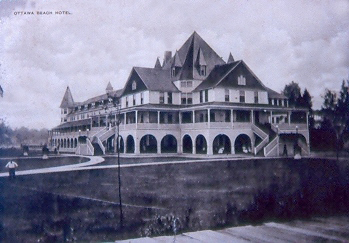Hotel Ottawa Audio Tour

Along the walkway between Black Lake East and Lake Michigan , the Ottawa Beach Hotel flourished as a major tourist destination in the early 20th century.
The following is its story
from construction to demise:
By the late 1870s, as lumber, West Michigan’s chief industry, began to play out, the increasingly affluent middle class from burgeoning Midwest cities that had been built with that lumber began seeking places to avoid the summer heat and city congestion. The excellent fishing on Black Lake lured the first summer vacationers to Holland. With its fine scenery, cool lake breezes, and close proximity to Chicago and Michigan’s largest cities, Holland proved a magnet to these tourists. Railroads and steamboats carried growing numbers of resorters to the shores of Black Lake. In December 1885, a group of prosperous Grand Rapids businessmen, including executives from the Chicago & West Michigan Railway, formed the West Michigan Park Association. The new group bought 75 acres of land on the north side of Black Lake (since 1935 Lake Macatawa) to create a resort of family cottages and a superb hotel on the bluff just north of this location. The association named the new hostelry Hotel Ottawa in honor of the Native Americans who first populated the area. The presence of the hotel spawned the name for the entire area: Ottawa Beach. The popularity of the Hotel Ottawa prompted the Chicago & West Michigan Railway in 1891 to extend its tracks along the north shore of Black Lake to the hotel, providing tourists direct access to the grounds. To meet the demands this would create, the West Michigan Park Association constructed a $15,000, 104-room annex west of the main hotel, connected to the main building by a covered walk.
As appealing as the Hotel Ottawa proved to be, the new ease of access made weekend stays possible, and the resort had difficulty filling rooms during the week. During the summer of 1893, the Columbian Exposition in Chicago diverted tourists from their regular destinations, and the Hotel Ottawa suffered financially and had to be mortgaged to pay its bills. By 1895, the hotel defaulted on the mortgage, and Charles Heald, a member of the West Michigan Park Association and general manager of the C&WM Railway, bought the hotel on behalf of the railroad for just $5,100. The railroad intended to invest heavily in the hotel complex to make it even more attractive to potential passengers and guests, including moving the hotel south, closer to Black Lake, and increasing the accommodations.
In February 1896, contractors began disassembling the waterfront entertainment buildings, filled in the marshy land along the shoreline to create a manicured esplanade, and deepened the channel to make the docking of steamers more convenient. By spring, workers set the hotel atop rollers, moved it south, and hoisted it upon an arched base that would serve as the first floor of the hotel. The addition of a steeply-pitched roof made the building appear new. A new elevated walkway over the railroad tracks connected the hotel to the Annex. Two years later, the railroad built a bath house at the Lake Michigan beach and extended its track a quartermile to bring guests on the new Toonerville Trolley from the hotel to the beach and back. The Chicago & West Michigan Railway profited from the heavy passenger traffic to Holland generated by the renovated Hotel Ottawa. In 1900, the Chicago & West Michigan merged with two other railroads, the Detroit, Grand Rapids & Western and the Flint & Pere Marquette, to form the Pere Marquette Railroad. Charles Heald became president of the newly formed enterprise, and the new railroad, spanning the east shore of Lake Michigan from Holland to Petoskey, focused upon the burgeoning lakefront resort traffic.
In 1901, the Pere Marquette undertook an ambitious $76,000 expansion of the hotel, consisting of a large 38-room addition, called the “New Hotel,” with tennis courts, a billiard parlor, and a nine-hole golf course. For the next two decades under the management of J. Boyd Pantlind, the Ottawa Beach Hotel, as the 1000-guest complex became generally known, would rank as one of the largest and finest resorts in the nation. By 1913, the Pere Marquette Railroad terminated rail service to Ottawa Beach and sold the hotel to J. Boyd Pantlind and his partners. By then, the West Michigan Pike ran from Indiana to Holland. Realizing that automobiles were the future of tourism, Pantlind began construction on a concrete road following the former railroad track. By 1919, guests could drive directly to the resort. In 1923, J. Boyd Pantlind’s son, Fred, with other local investors, assumed ownership of the Ottawa Beach Hotel and began planning more improvements. The hotel flourished, and its future success seemed assured, until a fire broke out in the late fall of 1923 that completely destroyed the complex. The hotel was never rebuilt. Such massive investment in a facility used but a few months a year and sited on land whose ownership was unclear, seemed unwise. In 1928, the State of Michigan transformed the area west and northwest of the hotel into the Holland State Park. Today, in a rather ironic twist, the park offers the very same camping, boating, and fishing activities that first attracted tourists in the late nineteenth century.
